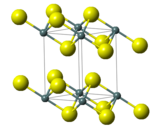Chemistry:Tin(IV) sulfide

| |
| Names | |
|---|---|
| IUPAC name
Tin(IV) sulfide
| |
| Other names
Tin disulfide, Stannic sulfide, Mosaic gold
| |
| Identifiers | |
3D model (JSmol)
|
|
| ChEBI | |
| EC Number |
|
PubChem CID
|
|
| UNII | |
| |
| Properties | |
| S2Sn | |
| Molar mass | 182.83 g·mol−1 |
| Appearance | Gold-yellow powder |
| Odor | Odorless |
| Density | 4.5 g/cm3[1] |
| Melting point | 600 °C (1,112 °F; 873 K) decomposes[1] |
| Insoluble | |
| Solubility | Soluble in aq. alkalis, decompose in aqua regia[1] Insoluble in alkyl acetates, acetone[2] |
| Structure | |
| Rhombohedral, hP3[3] | |
| P3m1, No. 164[3] | |
| 3 2/m[3] | |
a = 3.65 Å, c = 5.88 Å[3] α = 90°, β = 90°, γ = 120°
| |
| Octahedral (Sn4+)[3] | |
| Hazards | |
| GHS pictograms |  [4] [4]
|
| GHS Signal word | Warning |
| H302, H312, H315, H319, H332, H335[4] | |
| P261, P280, P301+312, P302+352, P304+340, P305+351+338, P332+313[4] | |
| NFPA 704 (fire diamond) | |
Except where otherwise noted, data are given for materials in their standard state (at 25 °C [77 °F], 100 kPa). | |
| Infobox references | |
Tin(IV) sulfide is a compound with the formula SnS2. The compound crystallizes in the cadmium iodide motif, with the Sn(IV) situated in "octahedral holes' defined by six sulfide centers.[5] It occurs naturally as the rare mineral berndtite.[6] It is useful as semiconductor material with band gap 2.2 eV.[7]
Reactions
The compound precipitates as a brown solid upon the addition of H2S to solutions of tin(IV) species. This reaction is reversed at low pH. Crystalline SnS2 has a bronze color and is used in decorative coating[8] where it is known as mosaic gold.
The material also reacts with sulfide salts to give a series of thiostannates with the formula [SnS2]m[S]2n−n. A simplified equation for this depolymerization reaction is
- SnS2 + S2− → 1/x[SnS2−3]x.
Applications
Tin (IV) sulfide has various uses in electrochemistry. It can be used in anodes of lithium ion batteries, where an intercalation process occurs to form Li2S.[9] It can also be used in a similar way in electrodes of supercapacitors, which can be used as alternative source of energy storage.[10]
SnS2 has also been identified as a potential component of thermoelectric devices, which convert thermal energy to electrical energy. In one example, this property was made possible by forming a composite of SnS2 with multiwalled carbon nanotubes.[11]
SnS2 can also be used in wastewater treatment. Forming a membrane with SnS2 and carbon nanofibers can potentially allow for the reduction of certain impurities in water, an example of which is hexavalent chromium.[12]
In general, SnS2 is useful as a semiconductor and can be purchased in powder form for experimental purposes.[13]
See also
References
- ↑ 1.0 1.1 1.2 Lide, David R., ed (2009). CRC Handbook of Chemistry and Physics (90th ed.). Boca Raton, Florida: CRC Press. ISBN 978-1-4200-9084-0.
- ↑ Comey, Arthur Messinger; Hahn, Dorothy A. (February 1921). A Dictionary of Chemical Solubilities: Inorganic (2nd ed.). New York: The MacMillan Company. p. 1080. https://archive.org/details/in.ernet.dli.2015.163725.
- ↑ 3.0 3.1 3.2 3.3 3.4 Voort, G.F. Vander, ed (2004). "Crystal Structure*". ASM Handbook 9 (Metallography and Microstructures): 29–43. doi:10.1361/asmhba0003722. ftp://ftp.asm-intl.org/pub/MARC_Records/V09/asmhba0003722.pdf.
- ↑ 4.0 4.1 4.2 4.3 "SDS of Stannic sulfide". Pfaltz & Bauer, Inc.. https://www.pfaltzandbauer.com/MSDS/S08330%20SDS%20061814.pdf.
- ↑ Wells, A.F. (1984) Structural Inorganic Chemistry, Oxford: Clarendon Press. ISBN:0-19-855370-6.
- ↑ Vaughan, D. J.; Craig, J. R. "Mineral Chemistry of Metal Sulfides" Cambridge University Press, Cambridge: 1978. ISBN:0-521-21489-0.
- ↑ L.A.Burton et al., J. Mater. Chem. A, 2016, 4, 1312-1318 DOI: 10.1039/C5TA08214E.
- ↑ Holleman, A. F.; Wiberg, E. "Inorganic Chemistry" Academic Press: San Diego, 2001. ISBN:0-12-352651-5.
- ↑ Cupid, D. M.; Rezqita, A.; Glibo, A.; Artner, M.; Bauer, V.; Hamid, R.; Jahn, M.; Flandorfer, H. (2021). "Understanding and Modelling the Thermodynamics and Electrochemistry of Lithiation of Tin (IV) Sulfide as an Anode Active Material for Lithium Ion Batteries". Electrochim. Acta 375.
- ↑ Setayeshmehr, M.; Haghighi, M.; Mirabbaszadeh, K. (2021). "A Review of Tin Disulfide (SnS2) Composite Electrode Materials for Supercapacitors". Energy Storage 4.
- ↑ Park, D.; Kim, M.; Kim, J. (2022). "Strongly Coupled Tin(IV) Sulfide—MultiWalled Carbon Nanotube Hybrid Composites and Their Enhanced Thermoelectric Properties". Inorg. Chem 61: 3723–3729.
- ↑ Zhong, Y.; Qiu, X.; Chen, D.; Li, N.; Xu, Q.; Li, H.; He, J.; Lu, J. (2016). "Flexible Electrospun Carbon Nanofiber/Tin(IV) Sulfide Core/Sheath Membranes for Photocatalytically Treating Chromium(VI)-Containing Wastewater". ACS Appl. Mater. Interfaces 8: 28671–28677.
- ↑ "Tin (IV) Sulfide (SnS2) Powder/Chunk/Lumps (CAS No.1315-01-1) | Stanford Advanced Materials" (in en). https://www.samaterials.com/tin/1864-tin-iv-sulfide-sns2-powder-chunk-lumps.html.
External links
 |


